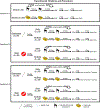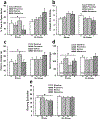A predator-based psychosocial stress animal model of PTSD in females: Influence of estrous phase and ovarian hormones
- PMID: 31421075
- PMCID: PMC6765406
- DOI: 10.1016/j.yhbeh.2019.104564
A predator-based psychosocial stress animal model of PTSD in females: Influence of estrous phase and ovarian hormones
Abstract
Traumatized women are more likely than traumatized men to develop post-traumatic stress disorder (PTSD). Still, the inclusion of females in animal models of PTSD has largely been avoided, likely due to the variable hormone profile of female rodents. Because a valid animal model of PTSD that incorporates females is still needed, we examined the influence of estrous stage and ovarian hormones on the female rat response to a predator-based psychosocial stress model of PTSD. Female Sprague-Dawley rats were exposed to psychosocial stress or control conditions for 31 days. Stressed rats were given two cat exposures and daily social instability; control rats were handled daily. Beginning on Day 32, rats underwent physiological or behavioral testing. In Experiment 1, vaginal smears were collected on days of the first and second cat exposures and each day of behavioral testing to determine estrous stage. In Experiments 2 and 3, ovariectomized or sham control rats were exposed to stress or control conditions. Then, they were given behavioral testing (Exp 2), or their hearts were isolated and subjected to ischemia/reperfusion on a Langendorff isolated heart system (Exp 3). Chronic stress increased anxiety-like behavior, irrespective of estrous stage or ovariectomy condition. Ovariectomized females displayed greater startle responses and anxiety-like behavior than sham rats. Stress had no impact on myocardial sensitivity to ischemic injury; however, ovariectomized females exhibited greater ischemia-induced infarction than sham rats. These findings suggest that ovarian hormones may prevent anxiety-like behavior and be cardioprotective in non-stressed controls, but they do not interact with chronic stress to influence the development of PTSD-like sequelae in female rats.
Keywords: Animal model; Estrous; Ovariectomy; PTSD; Sex differences; Stress.
Copyright © 2019 Elsevier Inc. All rights reserved.
Conflict of interest statement
DECLARATION OF INTEREST
The authors declare no potential conflicts of interest.
Figures





References
-
- Blizard DA, Lippman HR, Chen JJ, 1975. Sex differences in open-field behavior in the rat: the inductive and activational role of gonadal hormones. Physiology & behavior 14, 601–608. - PubMed
-
- Breslau N, Davis GC, Andreski P, Peterson E, 1991. Traumatic events and posttraumatic stress disorder in an urban population of young adults. Archives of general psychiatry 48, 216–222. - PubMed
-
- Breslau N, Davis GC, Andreski P, Peterson EL, Schultz LR, 1997. Sex differences in posttraumatic stress disorder. Archives of general psychiatry 54, 1044–1048. - PubMed
-
- Cohen H, Kaplan Z, Koresh O, Matar MA, Geva AB, Zohar J, 2011. Early post-stressor intervention with propranolol is ineffective in preventing posttraumatic stress responses in an animal model for PTSD. Eur Neuropsychopharmacol 21, 230–240. - PubMed
-
- Cohen H, Kaplan Z, Kozlovsky N, Gidron Y, Matar MA, Zohar J, 2010. Hippocampal microinfusion of oxytocin attenuates the behavioural response to stress by means of dynamic interplay with the glucocorticoid-catecholamine responses. Journal of neuroendocrinology 22, 889–904. - PubMed
Publication types
MeSH terms
Grants and funding
LinkOut - more resources
Full Text Sources
Medical
Miscellaneous

